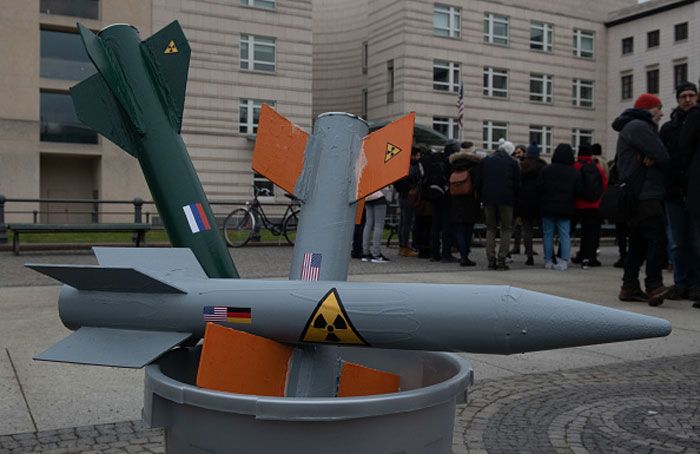A path toward renewing arms control
By Lawrence J. Korb | July 18, 2019
 Rocket models are stuck in a bucket during a February protest action in Berlin against the imminent withdrawal of the INF disarmament agreement between Russia and the USA. Photo: Paul Zinken/dpa
Rocket models are stuck in a bucket during a February protest action in Berlin against the imminent withdrawal of the INF disarmament agreement between Russia and the USA. Photo: Paul Zinken/dpa
At the late June G-20 meeting in Osaka, Japan, US President Trump and Russian President Putin met to discuss a number of issues, including Iran, Syria, Venezuela, Ukraine, and arms control. While all of these are important, none is more urgent at the current time than arms control because we are on the brink of a new arms race that could be an existential threat not only to these two nuclear super powers but to humanity.
To deal with the troubled arms control situation before it becomes a catastrophe, Global Priorities—an international network of experts, religious leaders, and non-governmental organization collaborators, all dedicated to reducing nuclear weapons, dangers, and expenditures, in favor of human needs—met in Rome last month to discuss the situation and propose some solutions to avert a disastrous outcome.
If the two major nuclear super powers, which between them account for more than 90 percent of the world’s nuclear weapons, do not act quickly, the era of arms control—which has lasted for more than 50 years and reduced the combined destructive potential of the two nuclear arsenals from 1.3 million Hiroshima bombs to about 80,000—will end. At that point, a new nuclear arms race, already under way, will accelerate. Unfortunately, the two presidents did not make any progress on this issue at their Osaka meeting. In fact, Putin complained publicly that President Trump did not even want to discuss extending New START (which limits each side to 1,550 deployed strategic nuclear weapons), the only strategic arms reduction treaty currently in place. It went into effect in 2010 and expires in 2021, unless the two nations jointly agree to extend it for another five years, which they can do without approval from the US Senate or the Russian Duma.
But an even more immediate issue is the Intermediate-range Nuclear Forces Treaty (INF). On August 2, 2019, this treaty between the United States and Russia will end, because the US has formally withdrawn from it. Negotiated by President Reagan and Soviet leader Gorbachev in 1987, the INF eliminated an entire class of weapons, that is, all ground-based missiles with ranges between 500 and 5,000 kilometers. The Trump administration gave its six-month notice to withdraw, claiming that Russia had violated the treaty by testing missiles with a range of about 500 kilometers.
This will be the second major arms control agreement with Russia from which the United States has withdrawn. In 2002, the US withdrew from the Anti-ballistic Missile (ABM) Treaty which had been in effect since the Nixon administration and which limited each side to one ballistic missile defense site. The Russians believe that by breaking out of the ABM, the United States has undermined the security of Moscow’s nuclear deterrent.
In February 2021, about 18 months from now, the New START, an agreement that took two years to negotiate, expires. President Trump and his advisors do not want to extend it unless China is also included.
Compounding disagreements about existing arms control agreements, the United States and Russia have both undertaken massive nuclear modernization programs that will make their existing arsenals much more lethal. Both countries have also begun to develop new weapons, including hypersonic missiles that might carry conventional or nuclear warheads and new tactical, smaller nuclear weapons that are, in theory, more “usable” in battle.
The 20 expert participants at the Global Priorities meeting in Rome included former Russian and American officials who actually participated in the negotiations that led to the existing arms control agreements between the two nations and who now work on these issues in major public policy research institutions and universities; US and Russian clergy; former UN officials; and former military officers who actually handled nuclear weapons during their time in service.
On June 19, as the conference in Rome was held, the US Defense Department posted a new edition of its official doctrine on the use of nuclear weapons. In demonstrating how far the United States has come from the Reagan assertion that a nuclear war cannot be won and must never be fought, the document states, “Using nuclear weapons could create conditions for decisive results and the restoration of strategic stability.” This post created such concern that it was actually taken down quickly from the Defense Department website. But no administration officials have actually contradicted the policy.
Over the course of two days, the Global Priorities sessions examined options for the United States and Russia to put negotiations on nuclear arms limits and reductions back on track; for developing a code of nuclear responsibility to reduce the risk of nuclear war; for including nuclear powers beyond the United States and Russia in arms control agreements; and for monitoring potential nuclear arms agreements.
The participants agreed that the current and near-term future environment for arms control is not positive. They came to this conclusion for several reasons. First, many of the changes in nuclear weapons and policy have not been integrated into the arms control regime. Also, public concerns about the nuclear threat have declined, so political leaders are under little or no pressure to reduce the risk of a nuclear conflict. Then again, many current US and Russian officials treat arms control as a negotiating chip for other issues rather than a central strategic concern. Further, new nuclear weapons and other weapons systems that might transform the strategic balance are not covered by existing arms control regimes and might therefore trigger a new arms race. And last, some Russian and American officials are making false and dangerous claims that, for example, “low yield” nuclear weapons can be used in battle without triggering an all-out nuclear war, or that new nuclear weapons can give one side a decisive advantage.
The experts at the Rome meeting made a number of suggestions aimed at improving the dismal arms control situation. They agreed that options need to be developed with respect to China’s role in nuclear arms reduction. But given that China has less than 300 strategic nuclear weapons and the United States and Russia thousands, these options can be developed only after New START is extended for another five years. Similarly, the experts agreed, after the INF Treaty expires, both sides should refrain from developing new nuclear weapons in Europe and work to resolve the issues that have led to the cancellation of the treaty. Russia claims that it had to deploy new intermediate-range missiles near its western border because the United States had positioned missile defense systems in Poland and Romania that can be easily converted to offensive use. After the START and INF issues are resolved, the two nations need to begin negotiations on how to deal with challenges to verification that will result from new and hybrid weapons systems, particularly hypersonics.
At the Rome meeting, religious leaders from the Vatican and the Russian Orthodox Church said that the threat posed by nuclear weapons and the merits of disarmament need to be taught and emphasized. Pope Francis has stressed this point repeatedly. Education of the public may seem a lesser priority compared to treaty negotiations, but leaders listen to their followers. It’s vital that the general public be better informed about nuclear dangers.
Global Priorities will convene another meeting of the group in October with a sharp focus on how tensions between the United States and Russia might be reduced, creating pathways to future understandings. Hopefully, the situation will not have deteriorated much further by then.
Together, we make the world safer.
The Bulletin elevates expert voices above the noise. But as an independent nonprofit organization, our operations depend on the support of readers like you. Help us continue to deliver quality journalism that holds leaders accountable. Your support of our work at any level is important. In return, we promise our coverage will be understandable, influential, vigilant, solution-oriented, and fair-minded. Together we can make a difference.
Keywords: Global Priorities, Rome
Topics: Analysis, Nuclear Weapons














